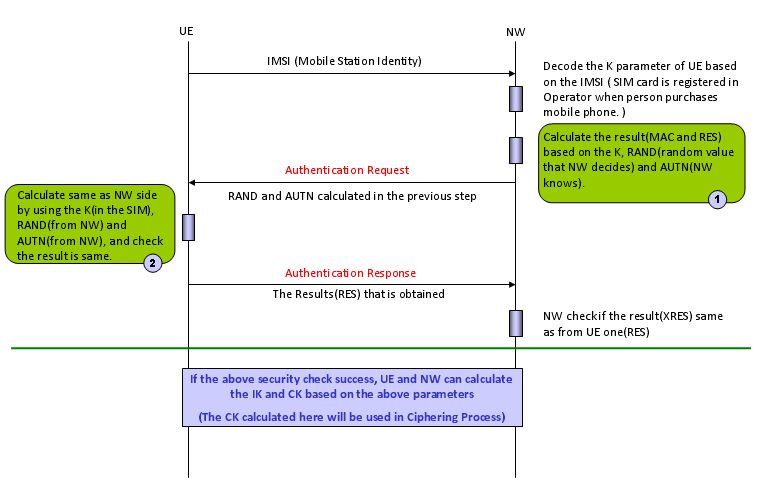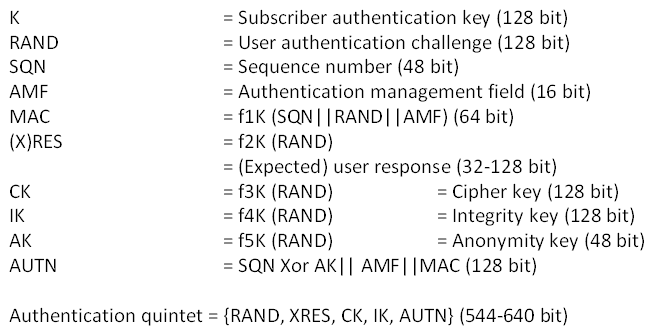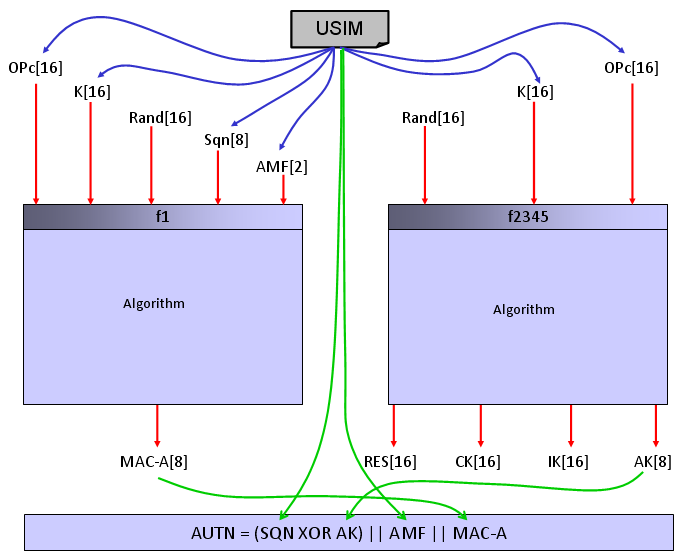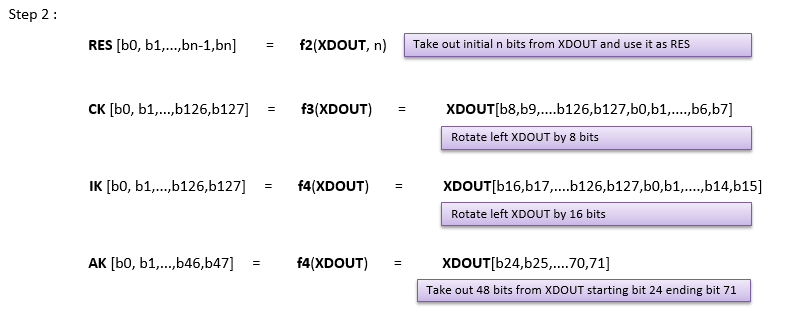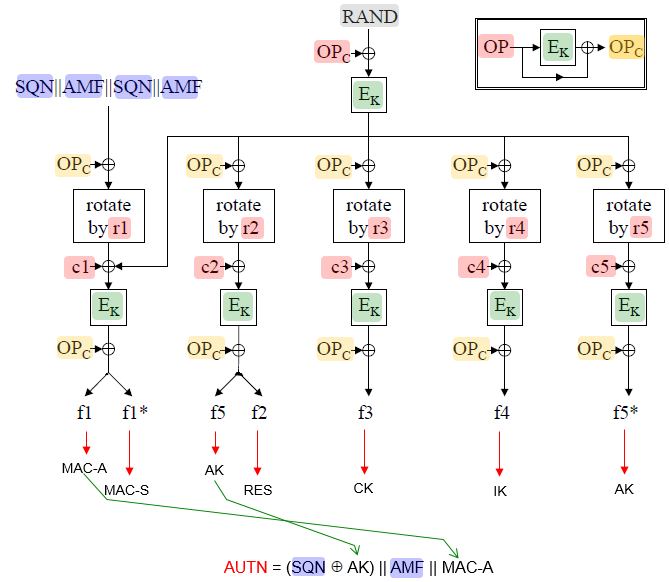|
4G/LTE - Authentication |
|||||||||||||||||||||||||||||||||||||||||||||||||||||||||||||||||||||||||||||||||||||||||||||||||||||||||
|
Authentication
Authentication is a process by which UE and Network check if the other party has right authority to communicate each other. It is very similar to 'login process' when you use a computer. The only difference is that in computer login process, only the computer is checking your authority and you are not technically checking the PC's authority (Of course, you have your own 'will' to use it or not to use it.. but it is not the technically determistic authentication algorithm). In LTE (in WCDMA as well), Network authenticate UE and UE also authenticate the Network. Authetication on both side should be passed for the communication to proceed. Followings are the list of topics that will be described in this page.
Authentication" process is a process similar to 'log in' process when you use a computer. In C2K and GSM, this authentication process is 'uni-directional', meaning that only Network authenticate UE and UE does not authenticate the network. As you may easily guess, this would cause a serious security problem. If I make a fake network which accept any UE, I can cheat a UE to camp on the fake network rather than the one the UE is supposed to camp on to. (But this kind of 'uni directional' authentication would make it so easy to test a UE using network simulator -:)
To improve this security issues, in LTE (in WCDMA as well) they do 'bi-directional' authentication, meaning that UE has to pass the authentication process and Newtork also has to pass the process as well.
The overall authentication process is as follows.
[Figure 1] Overall protocol sequence for Authentication (Authentication Key Generation and Exchange)
There are three main components of this authentication process : i) Input Parameters ii) Authentication Algorithm iii) Output Values (calcuated by Authentication Algorithm using the Input Parameters).
Both UE and Network uses the same Input Parameters and the same Authentication Algorithms, so they both should produce the same Output Values, otherwise Authentication fails.
One thing you have to keep in mind is that UE and Network exchange only Input Parameters and Output values, not the authentication Algorithm. Authentication Algorithm on UE side is stored in USIM and Authentication Algorithm on NW side is stored in Authentication Center. Both UE and NW just assume that they would use the identical algorithms.
Normally use use diffent Authentication Algorithm for testing and for live network. The most commonly used algorithm for testing is what we often call "Dummy XOR" algorithm which is defined in 36.508 section 4.9 Common test USIM parameters for LTE and 34.408 section 8 Test USIM Parameters for WCDMA.
The most common used algorithm in live network (as far as I know) is Milenage algorithm.
One example of Authentication Request and Authentication Response is as follows. You would notice that RAND, AUTN are carried by Authentication Request message and RES value is carried by Authentication Response.
NAS_LTE:EMM,Authentication request Authentication request ::= DIVISION +-Security header type ::= V | +-Security header type ::= CHOICE [Plain NAS message, not security protected] +-EPS mobility management protocol discriminator ::= V | +-Protocol discriminator ::= PD [7] +-Authentication request message type ::= V | +-Message type ::= MSG [52] +-Spare half octet ::= V | +-Spare half octet ::= FIX [0] +-NAS key set identifier ASME ::= V | +-TSC ::= CHOICE [native security context (for KSI ASME)] | +-NAS key set identifier ::= CHOICE [possible values for the NAS key set identifier 0] +-Authentication parameter RAND ::= V | +-Octet1-Octet16 ::= DIVISION | +-RAND value ::= OCTETARRAY SIZE(16..16) [A3DE0C6D363E30C364A4078F1BF8D577] +-Authentication parameter AUTN ::= LV +-Octet1 ::= DIVISION | +-Length of AUTN contents ::= LEN (0..255) [16] +-Octet2-Octet17 ::= DIVISION +-AUTN ::= OCTETARRAY SIZE(0..16) [5E726B56B4EC9001A3CF2E5E726BC6B5]
NAS_LTE:EMM,Authentication response Authentication response ::= DIVISION +-Security header type ::= V | +-Security header type ::= CHOICE [Plain NAS message, not security protected] +-EPS mobility management protocol discriminator ::= V | +-Protocol discriminator ::= PD [7] +-Authentication response message identity ::= V | +-Message type ::= MSG [53] +-Authentication response parameter ::= LV +-Octet1 ::= DIVISION | +-Length of Authentication response parameter contents ::= LEN (0..255) [8] +-Octet2-17 ::= DIVISION +-RES ::= OCTETARRAY SIZE(0..16) [A3CF2E5E726B56B4]
As you see from the two messages above, there are only three values which plays critical roles. RAND, AUTN, RES. RAND is not a calculated value.. it is just randomly assinged by network Authentication Center and AUTN and RES is calculated by special algorithm as illustrated below. (If you want to know the very detailed process, refer to 3GPP TS 35.206 V4.0.0 (2001-04) and analyze the source code line by line. If you just want to get general understanding, following illustration would be enough.)
[Figure 2] USIM Parameters and Derived Parameters for Authentication
Key Generation for Test USIM (based on 34.108)
Most of the USIMs that you are using with Test Equipment (i.e, Cellular Network Simulator) is based on what we call 3GPP Test USIM or Dummy XOR USIM. (Note : Recently.. espcially for LTE, some network operator requires using Test USIM using Milenage Algorithm. It might be because they want to use same/similar algorithm that they are using in live network). In this section, I will show you how to generate Authentication Key (AUTN) using 3GPP Test USIM algorithm and what kind of parameters are required for this. Since 3GPP Test USIM algoirthm is so simple and requires very small set of parameter, it is easy to implement and easy for debugging.
[Table 1] Input and output parameters of 3GPP Test USIM Algorithm
Followings are Parameters for the Input and Output of the 3GPP Test USIM Algorithm. Pay special attention to which parameter you have to know from your test USIM.
If you need to create a customized USIM or USIM Profile, you need to ask your USIM vendor if they can hardcode all the input parameters in the SIM and ask Test Equipment Vendor if user can specify all of the input parameters arbitrarily. (As far as I am experienced, most of the equipment vendor allow user to specify any K value and use the internal/hardcoded value for AMF, SQN. But some equipment vendor allows the user to set other input parameters as well)
NOTE 1 : IMSI is stored in USIM and play an important roles in some part of signaling, but it is not used in Authentication Process. NOTE 2 : OP, OPc is not used in Test USIM Algorithm
[Figure 3] Calculation of Authentication Key (AUTN) and IK, CK based on 3GPP 34.108 Test USIM Algorithm
Following is procedure of calculating Authentication Key (AUTN) and IK, CK based on 3GPP 34.108 Test USIM Algorithm.
Following is an example USIM parameter and the result of each step described above. You would not need any special program to try this. Just try with your hand.. if you are on a boring trip, this can be very good for killing time -:)
Refer to 3GPP TS 35.206 and you can get the C implementation of this algorithm and the code would tell you everything.
[Figure 4] Overview of Milenage Algorithm Following illustration is based on 35.206 Annex 1 and I added a couple of items.
NOTE : In every USIM parameter setting, the K value is one of the most important parameter. Where is the K in this diagram ? Actually the K is used to derive E_K value.
[Table 2] Input and output parameters of Milenage Algorithm
Followings are Parameters for the Input and Output of the Milenage Algorithm. This is what most of network operator uses. Pay special attention to which parameter you have to know from your test USIM.
If you need to create a customized USIM or USIM Profile, you need to ask your USIM vendor if they can hardcode all the input parameters in the SIM and ask Test Equipment Vendor if user can specify all of the input parameters arbitrarily. (As far as I am experienced, most of the equipment vendor allow user to specify any K, OP/OPc value and use the internal/hardcoded value for all other parameters. But some equipment vendor allows the user to set other input parameters as well. I haven't seen any equipment to allow user to set c1,c2,c3,c4,c5 and r1,r2,r3,r4,r5. They tend to use those values from 3GPP sample source code)
NOTE 1 : IMSI is stored in USIM and play an important roles in some part of signaling, but it is not used in Authentication Process.
Testing with Uknown USIM Algorithm / Parameters
In some rare case, people wants to test protocol stack without disclosing any information about Authentication Algorithm / parameters. If it is GSM or CDMA which does not require mutual Authentication (i.e, both UE side Authentication and Network side authentication needs to be completed), you can just configure the test equipment to skip the Authentication process. However, if you are working with WCDMA or LTE it is not possible for only one side (UE or Network) to skip the authentication unless both side agrees to skip the procedure. In order to let the test equipment to work with this kind of USIM, you need to get provided with the following output parameters and hardcode the authentication parameter on test equipment.
[Table 3] Input and output parameters of Unknown Algorithm/Unknown Input
In this case, you may ask test equipment vedor if the equipment can configure following output parameters directly. and ask USIM vendor to configure USIM to use a predefined values for the following parameters all the time.
|
|||||||||||||||||||||||||||||||||||||||||||||||||||||||||||||||||||||||||||||||||||||||||||||||||||||||||
